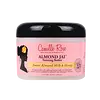What's inside
What's inside
 Key Ingredients
Key Ingredients

No key ingredients
 Benefits
Benefits

 Concerns
Concerns

 Ingredients Side-by-side
Ingredients Side-by-side

Water
Skin ConditioningBehentrimonium Methosulfate
Cetearyl Alcohol
EmollientPrunus Amygdalus Dulcis Fruit Extract
Skin ConditioningPrunus Amygdalus Dulcis Oil
Skin ConditioningCucurbita Pepo Seed Oil
EmollientSesamum Indicum Seed Oil
EmollientSimmondsia Chinensis Seed Oil
EmollientOryza Sativa Bran Oil
EmollientMacadamia Ternifolia Seed Oil
EmollientOlea Europaea Fruit Oil
MaskingCannabis Sativa Seed Oil
EmollientUlmus Fulva Bark Extract
MoisturisingRicinus Communis Seed Oil
MaskingAloe Barbadensis Leaf Juice
Skin ConditioningCera Alba
EmollientCamellia Sinensis Leaf Extract
AntimicrobialPhenoxyethanol
PreservativeCaprylyl Glycol
EmollientDiethyl Phthalate
MaskingWater, Behentrimonium Methosulfate, Cetearyl Alcohol, Prunus Amygdalus Dulcis Fruit Extract, Prunus Amygdalus Dulcis Oil, Cucurbita Pepo Seed Oil, Sesamum Indicum Seed Oil, Simmondsia Chinensis Seed Oil, Oryza Sativa Bran Oil, Macadamia Ternifolia Seed Oil, Olea Europaea Fruit Oil, Cannabis Sativa Seed Oil, Ulmus Fulva Bark Extract, Ricinus Communis Seed Oil, Aloe Barbadensis Leaf Juice, Cera Alba, Camellia Sinensis Leaf Extract, Phenoxyethanol, Caprylyl Glycol, Diethyl Phthalate
Water
Skin ConditioningOpuntia Ficus-Indica Seed Oil
EmollientPrunus Armeniaca Kernel Oil
MaskingUrtica Dioica Extract
AstringentCocos Nucifera Oil
MaskingAloe Barbadensis Leaf Juice
Skin ConditioningSimmondsia Chinensis Seed Oil
EmollientGlycerin
HumectantCetearyl Alcohol
EmollientRosa Canina Fruit Oil
EmollientEquisetum Arvense Extract
AstringentBehentrimonium Methosulfate
Olus Oil
EmollientAlmondeth-20
EmulsifyingTheobroma Cacao Seed Butter
EmollientPhenoxyethanol
PreservativeCitric Acid
BufferingWater, Opuntia Ficus-Indica Seed Oil, Prunus Armeniaca Kernel Oil, Urtica Dioica Extract, Cocos Nucifera Oil, Aloe Barbadensis Leaf Juice, Simmondsia Chinensis Seed Oil, Glycerin, Cetearyl Alcohol, Rosa Canina Fruit Oil, Equisetum Arvense Extract, Behentrimonium Methosulfate, Olus Oil, Almondeth-20, Theobroma Cacao Seed Butter, Phenoxyethanol, Citric Acid
Ingredients Explained
These ingredients are found in both products.
Ingredients higher up in an ingredient list are typically present in a larger amount.
Aloe Barbadensis Leaf Juice comes from leaves of the aloe plant. Aloe Barbadensis Leaf Juice is best known for helping to soothe sunburns. It is also anti-inflammatory, moisturizing, antiseptic, and can help heal wounds.
Aloe is packed with good stuff including Vitamins A, C, and E. These vitamins are antioxidants, which help fight free-radicals and the damage they may cause. Free-radicals are molecules that may damage your skin cells, such as pollution.
Aloe Barbadensis Leaf Juice also contains sugars. These sugars come in the form of monosaccharides and polysaccharides, folic acid, and choline. These sugars are able to help bind moisture to skin.
It also contains minerals such as calcium, 12 anthraquinones, fatty acids, amino acids, and Vitamin B12.
Learn more about Aloe Barbadensis Leaf JuiceBehentrimonium Methosulfate is an ammonium salt. It is mainly used to prevent static in haircare products as a surfactant.
Surfactants have differing ends: one side is hydrophilic while the other end is hydrophobic.
Surfactants also help your cleansers remove pollutants more easily from the skin.
Learn more about Behentrimonium MethosulfateCetearyl alcohol is a mixture of two fatty alcohols: cetyl alcohol and stearyl alcohol. It is mainly used as an emulsifier. Emulsifiers help prevent the separation of oils and products. Due to its composition, it can also be used to thicken a product or help create foam.
Cetearyl alcohol is an emollient. Emollients help soothe and hydrate the skin by trapping moisture.
Studies show Cetearyl alcohol is non-toxic and non-irritating. The FDA allows products labeled "alcohol-free" to have fatty alcohols.
This ingredient is usually derived from plant oils such as palm, vegetable, or coconut oils. There is debate on whether this ingredient will cause acne.
Due to the fatty acid base, this ingredient may not be Malassezia folliculitis safe.
Learn more about Cetearyl AlcoholPhenoxyethanol is a preservative that has germicide, antimicrobial, and aromatic properties. Studies show that phenoxyethanol can prevent microbial growth. By itself, it has a scent that is similar to that of a rose.
It's often used in formulations along with Caprylyl Glycol to preserve the shelf life of products.
This oil comes from the seeds of the desert shrub called Jojoba. It is more commonly known as jojoba oil, a non-comedogenic oil.
Jojoba oil does not contain fragrance and has many fatty-acids, making it a great soothing ingredient.
It also contains Vitamin E, a great moisturizing ingredient. Vitamin E is also an antioxidant and protects your skin against oxidative damage.
This ingredient humectant properties, meaning it helps draw moisture from the air. This helps keep your skin hydrated.
While jojoba has antibacterial properties, it is only able to kill some strains of bacteria.
Studies also show it helps in wound healing. In fact, Indigenous cultures have used jojoba as a moisturizer and to help treat burns for centuries.
Fun fact: Jojoba oil similar to natural human skin sebum, so it has a great effect on dry skin. It is also promising with helping to regulate sebum production.
Due to its fatty acid content, Jojoba oil may not be fungal acne safe. We recommend speaking with a professional if you have any concerns.
Learn more about Simmondsia Chinensis Seed OilWater. It's the most common cosmetic ingredient of all. You'll usually see it at the top of ingredient lists, meaning that it makes up the largest part of the product.
So why is it so popular? Water most often acts as a solvent - this means that it helps dissolve other ingredients into the formulation.
You'll also recognize water as that liquid we all need to stay alive. If you see this, drink a glass of water. Stay hydrated!
Learn more about Water